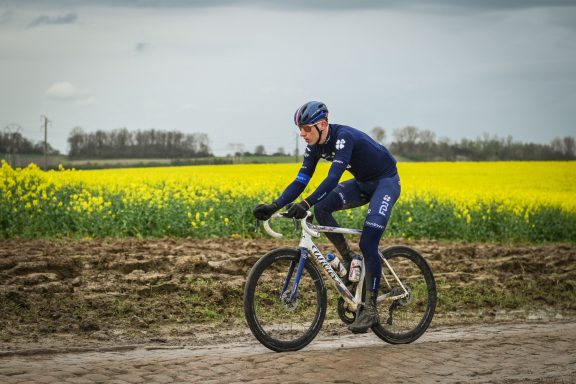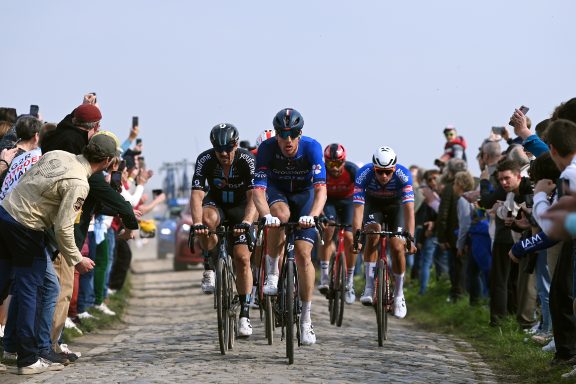Before the 2025 edition, the years followed each other and kind of looked alike for Stefan Küng at Paris-Roubaix. Unfortunately, his streak of three top-5 finishes in a row in the Queen of the Classics got interrupted this Sunday, especially due to a puncture and a crash in the final sixty kilometres. His fellow countryman Johan Jacobs was eventually the first Groupama-FDJ rider to reach the Roubaix velodrome, in 21st place. A frustrating conclusion to this 2025 cobbled Classics campaign.
Since the beginning of the spring, the Monuments follow one another. After the first thrills of Milan-Sanremo and the Tour of Flanders, the Classics campaign reached a kind of apotheosis this Sunday with Paris-Roubaix, perhaps the most beautiful of all, but undoubtedly the most unique. For this 122nd edition, no fewer than thirty cobbled sectors were in store for the riders, which represented fifty-five kilometres of unpaved roads out of the two hundred and sixty that made up the route from Compiègne to Roubaix. Competing for the tenth time in his career in the Hell of the North, Stefan Küng had legitimate ambitions given his consistency in previous years, but he first tried to get through the first part of the race as safe as possible, surrounded by his teammates. A breakaway of eight riders formed before the first sectors, but never benefited from a serious lead. Within the peloton, the selection first occurred from the back on the cobblestones, and Groupama-FDJ still had six riders in a peloton that was reduced by half at mid-race.
“It was a perfect race until Arenberg”, Frédéric Guesdon
Stefan Küng could therefore enjoy a perfect escort approaching the Haveluy sector, a crucial one as it preceded the Trouée d’Arenberg. Following an initial burst of acceleration, twenty riders went away, and the Swiss rider was still surrounded by Clément Russo and Johan Jacobs. The latter even took advantage of a brief pause to anticipate the Trouée d’Arenberg, which he tackled a few seconds ahead of the favorites. However, slightly behind at the start of this iconic sector, Stefan Küng was forced to make a huge effort to close the gaps, while the favorites were already in action a few seconds ahead of him. “It was a perfect race until Arenberg,” commented Frédéric Guesdon. “Then things got complicated as Clément punctured, and Stefan found himself a step behind”. “The feeling was good, unfortunately, I did half of Arenberg on foot,” explained Clément. “My race ended there. I’m a bit disappointed because I felt I could have supported Stefan much further.” A few seconds behind the first group after Arenberg, the Swiss rider was unable to bridge across immediately as it didn’t ease off in front of him, with lots of accelerations.
In the next sector, that of “Pont Gibus,” the Swiss rider pushed hard to come back, but as he just made it across, the race exploded for good. “He came back, but that’s when the strong breakaway of five riders went,” Frédéric said. Stefan Küng therefore found himself in a chasing group and tried to lead the pursuit, but the advantage of Mathieu van der Poel, Tadej Pogacar, Jasper Philipsen, Mads Pedersen, and Stefan Bissegger gradually grew, and reached one minute with 75 kilometres to go. The Swiss rider later benefited from the support of Pedersen, who was caught after a puncture, but was unable to go on with his attempt. “He suffered a puncture in Orchies,” said Frédéric. “He changed bikes, but found himself in another group behind, and the race was kind of over for us at that point. It never eased off at the front. When you have an incident in this race, especially in the final, it’s difficult to get the desired result.” As Mathieu van der Poel and Tadej Pogacar took off at the front to fight for victory, Stefan Küng found himself three minutes further back, battling for a decent result. “We caught him with what was left of the peloton, then he gave me the green light to attack for a top-10 or top-15,” Johan Jacobs added.
“It’s frustrating to finish this way”, Frédéric Guesdon
The latter was unable to get away in the final sectors, while his fellow countryman ended this unfortunate day with a crash, which definitively ruled him out from the top-10 fight. “It certainly wasn’t for the win anymore, but it’s still annoying,” said Frédéric. “He found himself way back and had nothing left to play for.” On the velodrome, Johan Jacobs eventually finished in a group battling for thirteenth place, but he had to settle for twenty-first. “It took me ten minutes to come back to life,” Johan said after the line. “I was completely dead. The race was very hard, from start to finish. There’s not much else to say.” Stefan Küng, who suffered a facial injury, received stitches after the race. A sad conclusion to a successful campaign until now. “We were here to get a result, especially since we had three consecutive top-5 finishes in Roubaix,” concluded Frédéric. “It’s a race that everyone in the team likes; we were all deeply committed, so it’s obviously frustrating to finish this way. Unfortunately, we know that these circumstances are of cycling, and it wasn’t meant to be for us this year. We’ll be back next year.”


